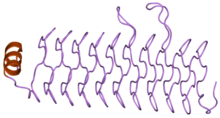Pentapeptide repeat
| Pentapeptide repeat | |||||||||||
|---|---|---|---|---|---|---|---|---|---|---|---|
 Structure of the pentapeptide repeat protein HetL.[1] | |||||||||||
| Identifiers | |||||||||||
| Symbol | Pentapeptide | ||||||||||
| Pfam | PF00805 | ||||||||||
| InterPro | IPR001646 | ||||||||||
| |||||||||||
Pentapeptide repeats are a family of sequence motifs found in multiple tandem copies in protein molecules.[2][3] Pentapeptide repeat proteins are found in all species, but they are found in many copies in cyanobacterial genomes. The repeats were first identified by Black and colleagues in the hglK protein.[4] The later Bateman et al. showed that a large family of related pentapeptide repeat proteins existed.[3] The function of these repeats is uncertain in most proteins. However, in the MfpA protein a DNA gyrase inhibitor it has been suggested that the pentapeptide repeat structure mimics the structure of DNA.[5] The repeats form a regular right handed four sided beta helix structure known as the Rfr-fold.
Sequence features


The pentapeptide repeat is a feature seen in
Structure
Pentapeptide repeats were initially predicted from sequence to possess a right handed beta helix with three sides.[3] The first crystal structure of a pentapeptide repeat protein was the MfpA protein solved by Hegde and colleagues. It showed that pentapeptide repeat proteins (PRPs) possessed a four sided beta helix structure.[5] Four repeats make up one turn of a solenoid like structure. The structures of eight different proteins have been solved to date.
| Protein | PDB code | Length | Number of repeats | Reference |
|---|---|---|---|---|
| Mycobacterium tuberculosis MfpA | PDB: 2bm4 | 183 | 30 | [5] |
| Cyanobacterium nostoc HetL | PDB: 3du1 | 237 | 40 | [1] |
| Enterococcus faecalis EfsQnr | PDB: 2w7z | 211 | [6] | |
| Nostoc punctiforme Np275 | PDB: 2J8I | 98 | 17 | [7] |
| Nostoc punctiforme Np276 | PDB: 2J8K | 75 | 12 | [7] |
| Cyanothece sp. Rfr32 | PDB: 2F3L PDB: 2G0Y | 167 | 21 | [8] |
| Cyanothece sp. Rfr23 | PDB: 2O6W | 174 | 23 | [9] |
| Arabidopsis thaliana At2g44920 | PDB: 3N90 | 224 | 25 | [10] |
